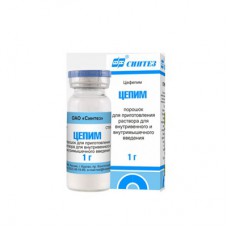Expiration date: 09/2026
Form release
Powder for preparation of solution for intravenous and intramuscular administration.
Composition
Composition per bottle:
active substance: cefepime hydrochloride monohydrate (in terms of cefepime) - 0, 5 g, 1 g.
excipient: arginine.
Packaging
The package 1 bottle.
Pharmacological action
Chain-antibacterial agent from the group of cephalosporins IV generation. Acts bactericidal, disrupting the synthesis of the cell wall of microorganisms. It has a broad spectrum of action against gram-positive and gram-negative bacteria, strains resistant to aminoglycosides and/or cephalosporin antibiotics of the III generation. Highly resistant to hydrolysis of the majority of beta-lactamases and quickly penetrates into gram-negative bacterial cells. Inside the bacterial cell, the molecular target is penicillin-binding proteins.
Active in vivo and in vitro for gram-positive aerobes: Staphylococcus aureus (methicillin-sensitive strains only), Streptococcus pneumoniae, Streptococcus pyogenes (group a), Streptococcus viridans, gram-negative aerobes: Enterobacter spp., Escherichia coli, Klebsiella pneumoniae, Proteus mirabilis, Pseudomonas aeruginosa.
In vitro is active against gram-positive aerobes: Staphylococcus epidermidis (methicillin-sensitive strains only), Staphylococcus saprophyticus, Streptococcus agalactiae (group B), gram-negative aerobes: Acinetobacter lwoffii,
Citrobacter diversus, Citrobacter freundii, Enterobacter agglomerans, Haemophilus influenzae (including strains producing beta-lactamase), Hafnia alvei, Klebsiella oxytoca, Moraxella catarrhalis (including strains producing beta-lactamases), Morganella morganii, Proteus vulgaris, Providencia rettgeri, Providencia stuartii, Serratia marcescens.
Most Enterococcus strains, including Enterococcus faecalis, methicillin-resistant Staphylococcus aureus, Stenotrophomonas maltophilia (formerly known as Xanthomonas maltophilia), Clostridium difficile are not sensitive to cefepime.
indications for use
Infectious and inflammatory diseases caused by microorganisms sensitive to the drug:
Pneumonia (moderate to severe) caused by Streptococcus pneumoniae (including cases of associated bacteremia), Pseudomonas aeruginosa, Klebsiella pneumoniae, or Enterobacter spp..
Febrile neutropenia (empirical therapy).
Complicated and uncomplicated urinary tract infections (including pyelonephritis) caused by Escherichia coli, Klebsiella pneumoniae, Proteus mirabilis.
Uncomplicated skin and soft tissue infections caused by Staphylococcus aureus (methicillin-sensitive strains only), Streptococcus pyogenes.
Complicated intraabdominal infections (in combination with metronidazole) caused by Escherichia coli, Klebsiella pneumoniae, Pseudomonas aeruginosa, Enterobacter spp., Bacteroides fragilis.
Prevention of infections during abdominal surgery.
Contraindications
Hypersensitivity to the components included in the composition of the drug Cepim (including antibiotic-cephalosporins, penicillins and other beta-lactam antibiotics),
children under 2 months of age (for intravenous administration) (safety and efficacy in children under 2 months is not established), children under 12 years of age (for intramuscular administration).
Caution: diseases of the gastrointestinal tract (including history): pseudomembranous colitis, ulcerative colitis, regional enteritis or antibiotic-associated colitis, chronic renal failure.
Method of application and doses
Chain is administered intravenously (in/in), intramuscularly (in/m) (only in complicated or uncomplicated urinary tract infections of mild and moderate severity caused by E. coli).
Doses and administration of the drug vary depending on the sensitivity of pathogens, severity of infection, as well as the state of kidney function in the patient.
Pneumonia (moderate to severe) caused by Streptococcus pneumoniae (including cases of associated bacteremia), Pseudomonas aeruginosa, Klebsiella pneumoniae, or Enterobacter spp.: 1 to 2 g every 12 h for 10 days.
Febrile neutropenia (empirical therapy): in/in 2 g every 8 h for 7 days or until neutropenia is resolved.
Complicated or uncomplicated urinary tract infections of mild to moderate severity caused by Escherichia coli, Klebsiella pneumoniae, Proteus mirabilis: in/or in/m (only for infections caused by Escherichia coli) 0.5-1 g every 12 h for 7-10 days.
Severe complicated or uncomplicated urinary tract infections (including pyelonephritis) caused by Escherichia coli or Klebsiella pneumoniae: in/in 2 g every 12 h for 10 days.
Moderate to severe skin and soft tissue infections caused by Staphylococcus aureus (methicillin-sensitive strains only), Streptococcus pyogenes: in/in 2 g every 12 h for 10 days.
Complicated intraabdominal infections (in combination with metronidazole) caused by Escherichia coli, Klebsiella pneumoniae, Pseudomonas aeruginosa, Enterobacter spp., Bacteroides fragilis: 2 g every 12 h for 7-10 days.
For the prevention of infection in surgical interventions on the organs of abdominal cavity: 60 minutes prior to surgery are introduced 2 g of the drug intravenously over 30 minutes. At the end of the infusion of an additional 500 mg of metronidazole intravenously. Metronidazole solutions should not be administered simultaneously with cefepime. The infusion system should be washed before the introduction of metronidazole.
During prolonged (more than 12 hours) surgical operations 12 hours after the first dose, repeated administration of 2 g of the drug intravenously for 30 minutes, followed by the introduction of 500 mg of metronidazole is recommended.
In children from 2 months to 16 years and weighing up to 40 kg the recommended dosing regimen for all indications (excluding febrile neutropenia) – 50 mg/kg every 12 hours in/in, with febrile neutropenia – 50 mg/kg every 8 h. Duration of treatment as adults (7-10 days).
In patients with impaired renal function (creatinine clearance<, 30=""p= "" >Patients who are on hemodialysis on the 1st day enter 1 g, then 0.5 g every 24 h for all infections and 1 g every 24 h for the treatment of febrile neutropenia. On the day of hemodialysis, the drug is administered after the hemodialysis session, it is desirable to introduce cefepime every day at the same time.
Data on the use of the drug in children with concomitant chronic renal failure are not available, however, given the similarity of pharmacokinetics in children and adults, dosing regimen (dose reduction or increase in the interval between injections) in children with chronic renal failure is similar to the dosing regimen in adults.To prepare a solution for the on / in the drug dissolved in 5 ml (0, 5 g) or 10 ml (1, 0 g) of sterile water for injection, 5% dextrose solution or 0, 9% sodium chloride solution. In/in struino injected for 3-5 minutes. For intravenous infusion, the prepared solution is combined with other solutions for intravenous infusion (0, 9% sodium chloride solution, 5% or 10% dextrose solution, ringer solution with lactate and 5% dextrose solution, the maximum concentration of 40 mg/ml) and administered for at least 30 minutes.
To prepare a solution for the/m drug is dissolved in sterile water for injection, 0, 9% sodium chloride solution, bacteriostatic water for injection with paraben or benzyl alcohol, 0, 5% and 1% lidocaine hydrochloride solution (0, 5 g in 1, 3 ml, 1, 0 g 2, 4 ml).
Side effect
Creatinine clearance (ml/min) | The recommended maintenance dose | |||
>, 50 | 2 g every 8 h (normal dose, no adjustment is required) | 2 g every 12 h (normal dose, no adjustment is required) | 1 g every 12 h (normal dose, no adjustment is required) | 500 mg every 12 h (normal dose, no adjustment required) |
30-50 | 2 g every 8 h | 2 g every 12 h | 1 g every 12 h | 500 mg every 12 h |
11-29 | 1 g every 12 h | 1 g every 24 h | 500 mg every 24 h | 500 mg every 24 h |
1 g every 24 h | 500 mg every 24 h | 250 mg every 24 h | 250 mg every 24 h | |
Allergic reactions: skin rash (including erythematous rashes), itching, fever, anaphylactoid reactions, eosinophilia, multiform exudative erythema (including Stevens-Johnson syndrome), rarely toxic epidermal necrolysis (Lyell's syndrome).
From the nervous system: headache, dizziness, insomnia, paresthesia, anxiety, confusion, convulsions, encephalopathy (in the absence of dose correction in patients with impaired renal function).
From the genitourinary system: vaginitis.
From the urinary system: impaired renal function.
From the gastrointestinal tract: diarrhea, nausea, vomiting, constipation or diarrhea, abdominal pain, dyspepsia, pseudomembranous colitis.
From the hematopoietic organs: anemia, thrombocytopenia, leukopenia, neutropenia, pancytopenia, hemolytic anemia, bleeding.
From the respiratory system: cough, chest pain.
From the cardiovascular system: tachycardia, shortness of breath, peripheral edema.
Laboratory parameters: decreased hematocrit, increased prothrombin time, increased concentration of urea, gipercreatininemia, hypercalcemia, increased activity "liver" transaminases and alkaline phosphatase, hyperbilirubinemia, positive Coombs ' test (without hemolysis).
Local reactions: intravenous-phlebitis, intramuscular-hyperemia and pain at the injection site.
Other: sore throat, thoracalgia, increased sweating, back pain, asthenia, the development of superinfection, oropharyngeal candidiasis.
Special instruction
When using cefepime, pseudomembranous colitis may occur. Therefore, it is important to bear in mind this diagnosis in case of diarrhea during treatment with the drug. Light forms of colitis do not require special treatment, it is enough to stop the drug, moderate or severe cases may require special treatment.
Cross-hypersensitivity in patients with allergic reactions to penicillins is possible.
At the combined severe renal and hepatic insufficiency it is necessary to define regularly concentration of a preparation in plasma (carry out correction of a dose depending on creatinine clearance).
Long-term treatment requires regular monitoring of peripheral blood, liver and kidney functional parameters.
With mixed aerobic-anaerobic infection, a combination with drugs active against anaerobes is appropriate before identification of pathogens. Patients who have meningeal dissemination from a remote source of infection, suspected meningitis or diagnosis of meningitis is confirmed, should be prescribed an alternative antibiotic with confirmed clinical efficacy for this situation.
Possible detection of a positive Coombs test, false-positive test for glucose in the urine.
Drug interaction
Pharmacologically incompatible with other antimicrobial drugs and heparin.
Diuretics, aminoglycosides, polymyxin To reduce the tubular secretion of cefepime and increase its concentration in the blood serum, extend T1/2, increase nephrotoxicity (increased risk of nefronekroz). Cefepime increases the ototoxicity of aminoglycosides.
Nonsteroidal anti-inflammatory drugs, slowing the excretion of cephalosporins, increase the risk of bleeding. At simultaneous appointment with bactericidal antibiotics (aminoglycosides) shows synergism with bacteriostatic (macrolides, chloramphenicol, tetracyclines) - antagonism.
Incompatible with a solution of metronidazole (before the introduction of metronidazole solution for the prevention of infections during surgery should wash the infusion system from a solution of cefepime). To avoid possible drug interaction with other drugs, solutions of cefepime (as well as most other beta-lactam antibiotics) should not be administered simultaneously with solutions of vankomycin, gentamicin, tobramycin, netilmicin. In the appointment of cefepime with these drugs should be administered each antibiotic separately.
Storage conditions
List B. in a dry, dark place at a temperature not exceeding 30 °C.
Keep out of reach of children.
Shelf life
2 years. Do not use after expiration date.


